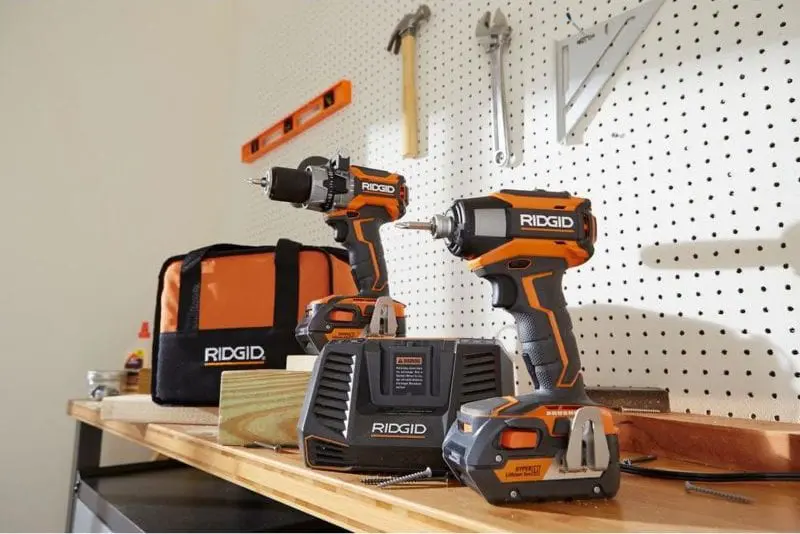Several of our readers have posed this common question to our staff: “Should I buy a drill or an impact driver?”
That’s a great question and one that comes up pretty early in the apprenticeship training process. Here’s the short answer: If you can only afford one tool, buy a drill. However, get a 2-tool kit with both if at all possible. With some of the deals we’ve seen, you can grab both of these tools without draining your bank account.
Should I Buy a Drill or an Impact Driver?
Let’s flesh this out a bit more and give you some solid rationale to make your purchase decision easier. It’s all based on how each tool works. The drill spins with a constant amount of pressure on the chuck until it has no more power to continue. That is unless you engage the clutch. We’ll talk about that in a moment. An impact driver has a hammer/anvil mechanism inside. As the hammers (usually two, but Metabo HPT has three) spin, they strike the anvils on their way around.
To understand the difference, imagine pushing as hard as you can against a punching bag versus punching it. With the push, you have less power on the bag itself, but you’re able to sustain that power smoothly. Punch the bag, and you drive much greater force—but only for a moment. A drill is akin to a push and an impact driver is like the punch.
So that makes it seem as if the impact driver has more power—and it does. So why buy a drill instead? We have several good reasons if you must decide between the two tools.
Why You Should Buy an Impact Driver Over a Drill
An impact driver’s driving mechanism and power make it a screw-driving specialist. No drill delivers the speed and ease of driving larger fasteners that an impact driver provides. You can even do light socket work with an impact driver. Be sure to use impact-rated sockets for that task, however.
When it comes to drilling holes. An impact driver works OK with twist bits and spade bits. Larger Forstner bits, self-feed bits, and hole saws use shanks that exceed the size of the hex collet. The impact driver is capable of getting these jobs done, but capacity plays a definite role.
Also, if you’re looking for smooth function and clean holes, all those impacts work against you. This is where the constant pressure of a drill is a much better option.
Why You Should Buy a Drill
So the drill takes care of drilling and boring tasks much better than an impact driver. You could use an impact for that task—in fact, some brands even make drill bits specifically for your impact driver. However, you just get better results with the drill and it provides a smoother drilling experience.

The drill may not be as fast as an impact driver on screws and other fasteners, but you won’t lose the quality of the result by using it. In fact, your results can actually improve. Using the clutch on a drill allows you to dial in the exact amount of driving force you want for the material you’re working with and the fasteners you have. That can leave a very clean, precise finish when all your screws are perfectly flush with your workpiece. Impact drivers tend to offer a little less finesse in the finish department.
But You Should Really Buy Both… If You Can Afford It
In an ideal world, you should have both tools so you have the best tool for all drilling and driving applications. This also gives you the ability to use the drill for pilot holes and use the impact driver to sink fasteners. Since you don’t have to switch bits for each fastener, you’re much more productive.
If you want a top-of-the-line solution like the Milwaukee M18 Fuel cordless drill and its 1200 in-lbs. of torque, you’re looking at $299 to get a kit with batteries. You’ll need to tack on another $70 to add the impact driver.
Top of the line is nice to have, and seasoned Pros love them. If you’re new to the trades, however, don’t feel as if you have to buy the best right away. After all, you don’t—or shouldn’t—be buying the same house your parents spent 20 years saving for the moment you graduate college and get married. You’ll wind up with more debt than you can carry. That can happen with your tools as well.
You can look to Ryobi, which offers a nice blend of entry-level performance with outstanding value. There, you can pick up a kit with batteries starting at around $100. You can move another step up into Pro performance with a Ridgid kit priced at $150. With the money you’re saving, you can add tools more quickly or save to buy those premium tools with cash rather than adding the interest you’ll accrue on a credit card.
Final Thoughts
With the extra money in your pocket, you’ll even be able to afford to take your wife out for a Thursday lunch date without worrying about credit card debt.
I love helping new Pros learn more about their chosen trades. If you have a question like “Should I buy a drill or an impact driver?”, feel free to hit up Pro Tool Reviews on Facebook, Twitter, or Instagram.







